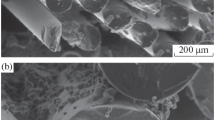Abstract—
We have determined the tensile mechanical strength of Nicalon CG and Tyranno SAK hollow core silicon carbide fibers after repeated heat treatments at a temperature of 900°C. Analysis of the effect of the number of heat treatment cycles on strength characteristics of the two types of fiber has shown that the statistical strength and Weibull modulus of the Nicalon CG fiber decrease considerably in comparison with those of the Tyranno SAK fiber, which is due to the increase in the number and size of defects on the Nicalon CG fiber as the number of heat treatment cycles increases.





Similar content being viewed by others
REFERENCES
Ceramic Fibers and Coatings: Advanced Materials for the Twenty-First Century, Washington, DC: National Academies, 1998. https://doi.org/10.17226/6042
Matthews, F.L. and Rawlings, R.D., Composite Materials: Engineering and Science, Cambridge: Woodhead, 1999.
Hopkins, G.R., SiC matrix/SiC fiber composite: a high-heat flux, low activation, structural material, J. Nucl. Mater., 1986, vol. 141, pp. 148–151. https://doi.org/10.1016/S0022-3115(86)80025-3
Evans, A.G. and Marshall, D.B., Mechanical behavior of ceramic matrix composites, Fiber Reinforced Ceramic Composites, Mazdiyani, K.S., Ed., San Diego: General Atomics, 1990, pp. 1–39.
Simon, G. and Bunsell, A.R., Creep behavior and structural characterization at high temperatures of Nicalon SiC fibers, J. Mater. Sci., 1984, vol. 19, pp. 3658–3670. https://doi.org/10.1007/BF02396938
Schreck, Ph., Vix-Guterl, C., Ehrburger, P., and Lahaye, J., Reactivity and molecular structure of silicon carbide fibers derived from polycarbosilanes, J. Mater. Sci., 1992, vol. 27, pp. 4243–4246. https://doi.org/10.1007/BF01105134
Luthra, K.L., Thermochemical analysis of the stability of continuous “SiC” fibers, J. Am. Ceram. Soc., 1986, vol. 69, pp. 231–233. https://doi.org/10.1111/j.1151-2916.1986.tb07344.x
Bender, B.A., Wallace, J.S., and Schrodt, D.J., Effect of thermochemical treatments on the strength and microstructure of SiC fibres, J. Mater. Sci., 1991, vol. 26, pp. 970–976. https://doi.org/10.1007/BF00576774
Flores, O., Bordia, R., Nestler, D., Krenkel, W., and Motz, G., Ceramic fibers based on SiC and SiCN systems: current research, development, and commercial status, Adv. Eng. Mater., 2014, vol. 16, no. 6, pp. 1–16. https://doi.org/10.1002/adem.201400069
Advanced SiC/SiC Ceramic Composites: Developments and Applications in Energy Systems, Kohyama, A. et al., Eds., Westerville: Am. Ceram. Soc., 2002. https://doi.org/10.1002/9781118406014
Ishikawa, T. and Oda, H., Heat-resistant inorganic fibers, Advances in High Temperature Ceramic Matrix Composites and Materials for Sustainable Development, Westerville: Am. Ceram. Soc., 2017, pp. 7–18. https://doi.org/10.1002/9781119407270.ch2
Utkin, A.V., Matvienko, A.A., Titov, A.T., and Baklanova, N.I., Multiple zirconia interphase for SiC/SiCf composites, Surf. Coat. Technol., 2011, vol. 205, nos. 8–9, pp. 2724–2729. https://doi.org/10.1016/j.surfcoat.2010.10.025
Tsirlin, A.M., Nepreryvnye neorganicheskie volokna dlya kompozitsionnykh materialov (Continuous Inorganic Fibers for Composite Materials), Moscow: Metallurgiya, 1992.
Lissart, N. and Lamon, J., Statistical analysis of failure of SiC fibers in the presence of bimodal flaw populations, J. Mater. Sci., 1997, vol. 32, pp. 6107–6117. https://doi.org/10.1023/A:1018600119250
Nyahumwa, C., Multiple defect distributions on Weibull statistical analysis of fatigue life of cast aluminium alloys, African J. Sci. Technol., 2010, vol. 6, no. 2, pp. 43–54. https://doi.org/10.4314/ajst.v6i2.55174
Thomason, J.L., On the application of Weibull analysis to experimentally determined single fibre strength distribution, Comp. Sci. Technol., 2013, vol. 77, pp. 74–80. https://doi.org/10.1016/j.compscitech.2013.01.009
Funding
This work was supported by the Russian Foundation for Basic Research, grant no. 18-29-17013.
Author information
Authors and Affiliations
Corresponding author
Additional information
Translated by O. Tsarev
Rights and permissions
About this article
Cite this article
Prokip, V.E., Lozanov, V.V., Bannykh, D.A. et al. Effect of Heat Treatment on the Mechanical Strength of Hollow Core Silicon Carbide Fibers. Inorg Mater 56, 241–248 (2020). https://doi.org/10.1134/S0020168520030152
Received:
Revised:
Accepted:
Published:
Issue Date:
DOI: https://doi.org/10.1134/S0020168520030152




